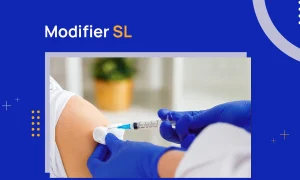Understanding medical billing codes is crucial for healthcare providers. Their correct usage is the backbone of medical revenue. This is especially true for physical (PT) and occupational therapy (OT) clinics, as most of their revenue stream is based on time-based services. Among hundreds of PT and OT codes, CPT code 97112 is among the most frequently used in the therapeutic industry.
However, many insurance claims are still denied. The reason? Incorrect medical coding and mistakes in using code 97112. This leads to claim denials, delays in payments, and a loss of revenue.
In this blog, we will discuss how to effectively use CPT code 97112 in your claims, the modifiers you can append, and some real-world scenarios to clear the picture. So, let’s start.
CPT Code 97112 Description
The official CPT manual defines CPT code 97112 as: “Therapeutic procedure, one or more areas, each 15 minutes; neuromuscular reeducation of movement, balance, coordination, kinesthetic sense, posture, and/or proprioception for sitting and/or standing activities.”
In simple English, CPT code 97112 is used to bill specialized therapeutic interventions focused on neuromuscular reeducation and help patients regain control of their movement, balance, coordination, and awareness of body position. Usually, these types of services are needed after a severe injury, surgery, or some neurological events that significantly disrupt normal movement patterns.
But here’s where the confusion starts. Neuromuscular reeducation (NMR) is not the same as therapeutic exercise (97110), although they are very similar. So, what’s the difference? Well, NMR targets the nervous system’s communication with the muscular system. Rather than focusing solely on strength and endurance.
Some neuromuscular reeducation techniques include:
- Proprioceptive Neuromuscular Facilitation (PNF) patterns
- Balance training with specialized equipment
- Postural control exercises
- Sensory integration activities
- Movement pattern retraining
- Vestibular rehabilitation techniques
Another crucial thing to note is that 97112 is a time-based code. So, its billing is based on the 8-minute rule, which means that you will bill in 15-minute increments. You can not use this code for group therapy or unsupervised activities!
Appropriate Use Cases for CPT Code 97112
To better understand the difference between CPT code 97112 and other related codes and when to use it, let’s look at some real-world usage scenarios:
Neurological Conditions and Injuries
Patients suffering from movement and coordination issues due to neurological conditions often need neuromuscular reeducation exercises. Common scenarios can be:
- Stroke rehabilitation
- Traumatic brain injury (TBI)
- Multiple sclerosis
- Parkinson’s disease
Functional Deficits
The code is also appropriate when addressing specific functional deficits:
- Gait abnormalities
- Postural dysfunction
- Coordination impairments
- Proprioceptive deficits
Modifiers to Append with CPT Code 97112
Modifiers are an essential tool in medical billing. Without proper modifiers, your claim will be denied. The following modifiers are most frequently used with CPT code 97112:
| Modifier | Description | Application |
|---|---|---|
| GP | Services delivered under an outpatient physical therapy plan of care | Must be applied to all physical therapy services |
| GO | Services delivered under an outpatient occupational therapy plan of care | Must be applied to all occupational therapy services |
| GN | Services delivered under an outpatient speech-language pathology plan of care | Must be applied to all speech therapy services |
| CQ | When a physical therapy assistant provides >10% of the service | 15% payment reduction |
| CO | When an occupational therapy assistant provides >10% of the service | 15% payment reduction |
| 59 or XS | Distinct/Separate Service | When 97112 is provided alongside another therapy code that might normally be bundled (like chiropractic care) |
| KX | Medical necessity exception | When exceeding therapy threshold amounts under Medicare, while documenting continued medical necessity |
You can’t imagine how many clinics lose money when they forget to append the assistant modifiers (CQ and CO). Yes, using them means a payment reduction, but failing to use them when required can trigger audits and much costlier recoupments!
Reimbursement Guidelines for CPT Code 97112
The following guidelines will help you file clean code 97112 claims.
The 8-Minute Rule and Time-Based Billing
As we mentioned earlier, CPT code 97112 is time-based. This means that with Medicare and other insurers, you have to use the 8-minute rule for billing and reimbursement. This rule determines how many units can be billed based on the total treatment time:
| No. of Units | Service Time |
|---|---|
| 0 unit | 0-7 minutes |
| 1 unit | 8-22 minutes |
| 2 units | 23-37 minutes |
| 3 units | 38-52 minutes |
| 4 units | 53-67 minutes |
Medicare Reimbursement Rates
Medicare’s 2025 Physician Fee Schedule dropped neuromuscular reeducation to an average of $32.02 per unit nationally (down from $33.62 in 2024). It is frustrating but not surprising, given the ongoing reimbursement pressure. Local rates may differ based on geographic practice cost indices (GPCIs).
On the other hand, the reimbursement rate of private insurance companies varies a lot. The average rate ranges between $25 to $65 per unit. Many commercial payers follow Medicare’s guidelines but may have their own fee schedules and documentation requirements.
Documentation
Documentation is vital to the success of your claims. Without proper documentation, your claims are bound to be denied. Comprehensive documentation justifies the need for the provided services and strengthens your claims. For CPT code 97112, make sure to include the following:
- Specific neuromuscular deficits that are being addressed (e.g., impaired balance, proprioception, coordination).
- Description of interventions provided (techniques, equipment used).
- Skilled components of the treatment that require professional expertise.
- Response to treatment and progress toward goals.
- Functional outcomes and how the treatment is improving daily activities.
- Time spent on the procedure, including start and end times.
Final Thoughts on CPT Code 97112
CPT code 97112 represents a valuable therapeutic procedure that helps patients regain neuromuscular function and improve their quality of life. However, billing it can be tricky, as it is closely related to other codes. The secret to proper billing of 97112 lies in thorough documentation, accurate code selection, proper modifier application, and time tracking.
If you are facing claim denials even after following all the guidelines in this blog, consider getting our physical therapy billing services. Our billing experts have decades of experience handling billing issues and denials.



